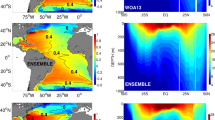Abstract
The article proposes parallel implementation of the Ensemble Optimal Interpolation (EnOI) data assimilation (DA) method in eddy-resolving World Ocean circulation model. The results of DA experiments in North Atlantic with ARGO drifters are compared with the multivariate optimal interpolation (MVOI) DA scheme. The sensitivity of the model error, i.e., the difference between the model and observations depending on the number of ensemble elements, is also assessed and presented. The effectiveness of this method over the MVOI scheme is confirmed. The model outputs with and without assimilation are also compared with independent sea surface temperature data from ARMOR 3d.
Similar content being viewed by others
References
V. I. Agoshkov, V. M. Ipatova, V. B. Zalesnyi, E. I. Parmuzin, and V. P. Shutyaev, “Problems of variational assimilation of observational data for ocean general circulation models and methods for their solution,” Izv. Atmos. Ocean. Phys. 46 (6), 677–712 (2010).
V. I. Agoshkov, E. I. Parmuzin, and V. P. Shutyaev, “Observational data assimilation in the problem of Black Sea circulation and sensitivity analysis of its solution,” Izv., Atmos. Ocean. Phys. 49 (6), 592–602 (2013).
K. P. Belyaev, C. A. S. Tanajura, and N. P. Tuchkova, “Comparison of methods for argo drifters data assimilation into a hydrodynamical model of the ocean,” Oceanology (Engl. Transl.) 52 (5), 593–603 (2012).
R. A. Ibrayev, R. N. Khabeev, and K. V. Ushakov, “Eddy-resolving 1/10° model of the World Ocean,” Izv., Atmos. Ocean. Phys. 48 (1), 37–46 (2012).
V. V. Kalmykov, R. A. Ibrayev, “The overlapping algorithm for solving shallow water equations on massivelyparallel architectures with distributed memory,” Vestnik UGATU 17 (5 (58)), 252–259 (2013).
V. V. Kalmykov, R. A. Ibrayev, and K. V. Ushakov, “The problems and challenges in the modeling of the high resolution Earth system,” in Supercomputer Technologies in Science, Education, and Industry: Almanac, Ed. by V. A. Sadovnichii, (Moscow State Univ., Moscow, 2014), pp. 14–22.
V. V. Kalmykov and R. A. Ibrayev, “A framework for the ocean-ice-atmosphere-land coupled modeling on massively-parallel architectures” Vychisl. Metody Programm., No. 14, 88–95 (2013).
M. N. Kaurkin, R. A. Ibrayev, and K. P. Belyaev, “Data assimilation in the ocean circulation model of high spatial resolution using the methods of parallel programming,” Russ. Meteorol. Hydrol. 41 (7), 479–486 (2016).
V. V. Knysh, G. K. Korotaev, A. I. Mizyuk, and A. S. Sarkisyan, “Assimilation of hydrological observation data for calculating currents in seas and oceans,” Izv., Atmos. Ocean. Phys. 48 (1), 57–73 (2012).
G. I. Marchuk and V. P. Shutyaev, “Conjugate equations and iterative algorithms in the tasks of variational data assimilation,” Tr. Inst. Matem. Mekh. im. N.N. Krasovskogo 17 (2), 136–150 (2011).
K. V. Ushakov, T. B. Grankina, and R. A. Ibrayev, “Modeling the water circulation in the North Atlantic in the scope of the CORE-II experiment,” Izv., Atmos. Ocean. Phys. 52 (4), 365–375 (2016).
K. V. Ushakov, R. A. Ibrayev, and V. V. Kalmykov, “Simulation of the World ocean climate with a massively parallel numerical model,” Izv., Atmos. Ocean. Phys. 51 (4), 362–380 (2015).
J. I. Antonov, D. Seidov, T. P. Boyer, et al., World Ocean Atlas 2009, Ed. by S. Levitus (US Government Printing Office, Washington, 2010).
R. Bleck, “An oceanic general circulation model framed in hybrid isopycnic Cartesian coordinates,” Ocean Model. 4, 55–88 (2002).
G. Evensen, Data Assimilation, the Ensemble Kalman Filter, 2nd ed. (Berlin, Springer-Verlag, 2009).
GODAE Ocean View Science Team, Work Plan 2009, 2013, http://www.godae-oceanview.org.
S. M. Griffies, A. Biastoch, C. Böning, et al., “Coordinated ocean-ice reference experiments (COREs),” Ocean Model. 26 (1–2), 1–46 (2009).
E. Kalnay, H. Li, T. Miyoshi, et al., “4-D-Var or ensemble Kalman filter?” Tellus A 59 (5), 758–773 (2007).
E. Kalnay, Atmospheric Modeling, Data Assimilation, and Predictability (Cambridge Univ. Press, Cambridge, 2003).
W. Large and S. Yeager, “The global climatology of an interannually varying air–sea flux data set,” Clim. Dyn. 33 (2–3), 341–364 (2009).
G. Larnicol, S. Guinehut, M.-H. Rio, et al., “The global observed ocean products of the French Mercator project,” Proceedings of the Symp. on 15 Years of Progress in Radar Altimetry, March 13–18, 2006 (Venice, 2006).
P. R. Oke, G. B. Brassington, D. A. Griffin, and A. Schiller, “Ocean data assimilation: a case for ensemble optimal interpolation,” Austral. Meteorol. Oceanogr. J. 59, 67–76 (2010).
P. Sakov, F. Counillon, L. Bertino, et al., “TOPAZ4: an ocean-sea ice data assimilation system for the North Atlantic and Arctic,” Ocean Sci. 8, 633–656 (2012).
A. Schiller and G. B. Brassington, Operational Oceanography in the 21st Century, Ed. by A. Schiller and G. B. Brassington (Springer-Verlag, Dordrecht, 2011).
C. Schrum and J. Backhaus, “Sensitivity of atmosphere-ocean heat exchange and heat content in North Sea and Baltic Sea. A comparative assessment,” Tellus A 51, 526–549 (1999).
C. A. S. Tanajura and K. Belyaev, “A sequential data assimilation method based on the properties of a diffusion-type process,” Appl. Math. Model. 33 (5), 2165–2174 (2009).
J. Xie and J. Zhu, “Ensemble optimal interpolation schemes for assimilating Argo profiles into a hybrid coordinate ocean model,” Ocean Model. 33, 283–298 (2010).
Author information
Authors and Affiliations
Corresponding author
Additional information
Original Russian Text © M.N. Kaurkin, R.A. Ibrayev, K.P. Belyaev, 2016, published in Okeanologiya, 2016, Vol. 56, No. 6, pp. 852–860.
Rights and permissions
About this article
Cite this article
Kaurkin, M.N., Ibrayev, R.A. & Belyaev, K.P. ARGO data assimilation into the ocean dynamics model with high spatial resolution using Ensemble Optimal Interpolation (EnOI). Oceanology 56, 774–781 (2016). https://doi.org/10.1134/S0001437016060059
Received:
Published:
Issue Date:
DOI: https://doi.org/10.1134/S0001437016060059



